How to Make Cultured Butter
Cultured butter is now synonymous with European-style butter, however it was once common in the States, at least until the rise of “sweet cream” butter, which is the American standard now. The spread of sweet cream butter was based on a technological innovation: refrigeration. For it was refrigeration that made it possible to get milk from the farmer’s barn to the dairy before it soured due to the action of lactic acid bacteria. Americans preferred their butter sweeter, without the slightly tangy, some say “cheesy”, aftertaste. However there are times when tang and complexity are very desirable things indeed.
Cultured butter is getting more popular in the US, which is not to say it’s available everywhere. So why not make it? All you need is some heavy cream, some other sort of fermented milk product (sour cream, buttermilk or yogurt), a food processor and some time. Since cultured butter is based on soured cream, that’s where we need to start.
Here I have a quart of cream. I initially planned to run off to the specialty shop and buy some local bottled cream for this, since I wanted to impress you with how profoundly authentic my life is. Then I remembered what my life is really like and went to Kroger. The results would have been excellent either way.

Next I added my “culture”, in this case some buttermilk, though any bacteria-rich milk product hanging around in the fridge (like sour cream or yogurt) would have done nicely. I added about a tablespoon per cup.

I didn’t add any more than that because I didn’t want to risk diluting the fat content of the mixture. In order to whip cream you need a minimum of 30% milk fat in the mix. This is why I soured my own heavy cream for this project instead of just buying sour cream, because commercial sour creams aren’t made from full-fat cream. They’re made from light cream (about 15 percent milk fat) thickened with additives like gelatin or guar gum. Wouldn’t you just know it? I stirred it up…
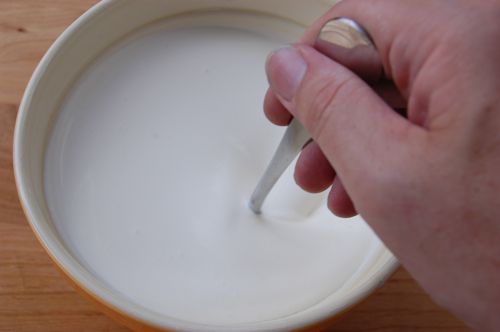
…covered it with plastic and let it sit overnight. Presto change-o:

All done, but speaking for myself, I prefer to churn it when it’s chilled (makes the finished butter firmer). So off it goes into the fridge for a few hours. I should have taken a picture of what the sour cream looked like coming out of the fridge because it was even thicker than normal commercial sour cream. However when you stir it up the matrix breaks (as with yogurt) and it becomes soupier. Here I poured the stirred sour cream into the bowl of my food processor…
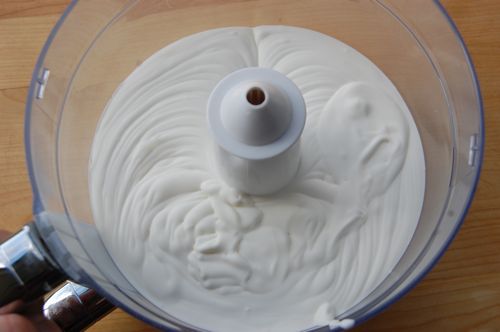
…and switched it on. After about a minute it whipped up to, essentially, sour whipped cream.
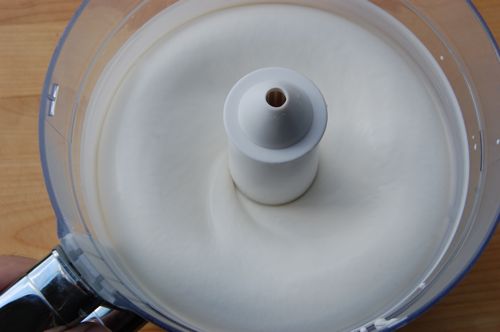
Another full minute and it showed signs of breaking.
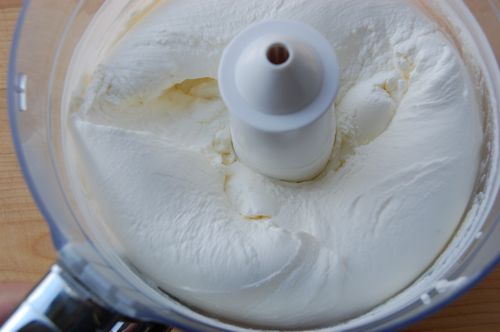
Another full minute after that and butter grains began to form…

…and finally fifteen seconds later the whole mixture separated into butter and buttermilk.
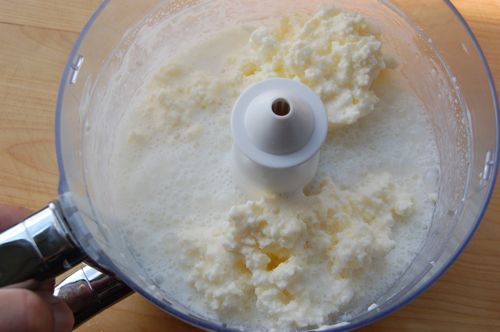
I strained the whole mess…
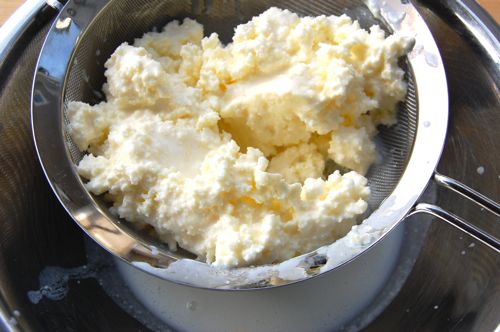
…then, in a separate bowl, used a big fork to knead the butter and squeeze out any remaining pockets of buttermilk.

After about a minute of kneading and pouring off buttermilk, I had thirteen ounces of cultured butter.
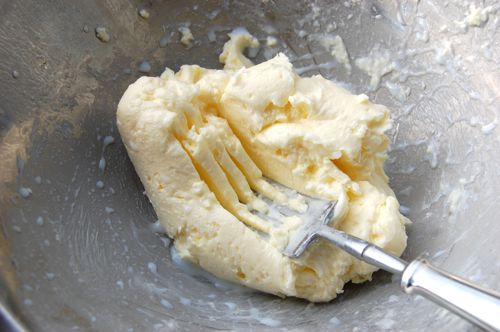
Now then, I should mention that it’s not possible to make butter at home that’s “dry” enough to use for laminated pastry like croissants and puff pastry. However this is an excellent general-purpose butter, for spreading on toast and cooking with. I’ve used my own butter for pie crusts and buttercream, though since it’s a bit wetter than commercial butter, the results aren’t quite as good compared to the store bought stuff. That said, I had the caché of being able to say I made the butter myself!
UPDATE: Reader Evan adds:
I would dispute your assertion that it is not possible to make “dry” enough butter for puff pastry at home. I myself have inadvertently overdried butter to the point that it was nearly 100% fat. The simplest method is to place your butter wad into a flour sack towel and twist down to squeeze the hell (and buttermilk) out of it. With enough effort (and periodic kneading to homogenize the wad and allow more water to the surface), a great deal of buttermilk can be expelled. I don’t know if this is “dry” enough for puff pastry (perhaps it is too dry!), but it certainly at least as high in fat percentage as store bought butter.
Also, these extra tips:
First, don’t use products with only acidophilus cultures. They won’t grow at low temps, and you’ll wind up with cream that has yogurt in it, rather than a cultured cream. It’s still usable, but will resemble sweet cream butter instead of cultured butter.
Second, I double checked my weights to approximate the fat percentage in my final butter. I started with 16 oz of cream and added 1 oz of yogurt. Assuming Snowville’s heavy whipping cream is 36% butter fat (I can’t find the exact number), there’s 5.76 oz of fat in this cream. My final butter weight, after pressing, was 6.61 oz. There’s some loss involved, obviously, but for the sake of argument let’s assume that all the fat (or most of it) got into my butter. That puts the fat percentage by weight at 87%. Obviously this number is a little high, since I ignored loss and the weight of the yogurt, but I think it’s a pretty good indication that the butter is at least commercial grade in terms of fat percentage. I also obtained about 10 oz of buttermilk – enough for pancakes!
If you don’t mind me asking- what ends up being the difference between whipping the heavy whipping cream into butter, and introducing the sour cream?
I have Krogers here, too, and recently I’ve taken an old spaghetti jar and filled it 1/3 with Kroger brand HWC, then shaken until the fats and buttermilk separated. (I have few kitchen tools.)
The main curiosity is the difference between what I had made, and what cultured butter would taste like, and thusly used for.
Hi Rachel! The only difference is flavor. Cultured butter has a bit of a tang to it, which some people feel gives it a lighter “cleaner” taste than sweet cream butter. The reason is partly physiological. Acid (which is in the soured cream) reduces the “fatty” feeling of butter on the tongue. So even though you’re eating the same amount of fat, the impression is that cultured butter is somehow less fatty. It isn’t true of course, it just seems that way! 😉
I can’t believe for authenticity sake you didn’t pull out a churn for this process. Guess that idea went the way of the local bottled cream. I might have to try this for the fun of it. Is there any reason I couldn’t use something like a Vitamix or Blendtec to do the whipping part instead of the food processor. I have both but just wondered if that would work.
Hey LInda!
I’m not sure it would work in a blender, actually. I think you’d need a bigger agitator than that little blade. You could do it in a mixer I’ll bet!
But you know I could probably find a butter churn at a flea market here in Kentucky. I know I’ve seem then around. Nice idea!
– Joe
Hi Joe,
I’ve arrived here from your recent post on cultured butter. I was wondering whether you knew how much salt should be added to have nicely salted butter?
Loving the fat posts (if that’s the right phrase)!
Many thanks,
Julie
Hey Julie! Thanks very much! I’m having fun myself! Salted butter is generally 1-2% salt. So my suggestion would be to weigh your finished product on a digital scale, switched to grams. For every 100 grams mix in a gram of salt!
– Joe